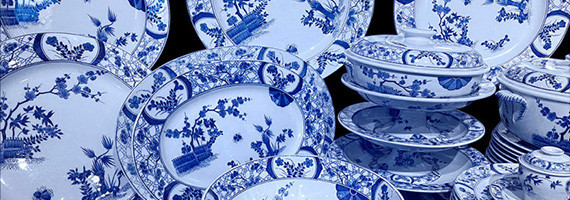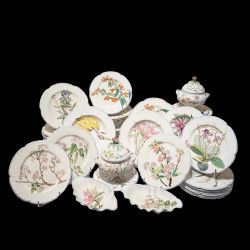Search
Categories
- OUR COLLECTIONS
- Decorations & Christmas
- Decorative tin plates
- Dinnerware
- Red Coral Collection
- Edible Plants Collection
- Edible Mushrooms Collection
- Nemo Collection
- Vegetable garden collection
- Forest Collection
- George Sand Collection
- Animals
- Collection Mozart
- Rousseau Collection
- Marks of Time Collection
- Mixed Clay Collection
- Graphic collection
- Red Nose Christmas Collection
- Table accessories
- Crystal, Glass
- Melamine, rattan, tray
- Flatware
- OTHER COLLECTIONS
- ANTIQUES
- WHAT'S NEW
- GIFTS IDEAS
- WEDDING LIST
- SPECIAL OFFERS
19th-century fine earthenware

Bracquemond Creil & Montereau
As soon as it was exibited at French internationnal fair in 1867, this service was the most successful In 1866, wishing to embrace the revival of ceramics decorated by transfer printing, Eugène Rousseau sought the collaboration of the painter and engraver Félix Bracquemond. Bracquemond found inspiration for his animal and plant motifs (around 280), in Hokusai’s Manga (1815), Hiroshige’s Grand Series of Fishes (1830) and Taito’s Flower and Bird Paintings (1848), for his innovative, asymetric designs on plates featuring one primary image and two, usually smaller, supplementary images. From its first presentation at the 1867 Universal Exhibition in Paris, the dinner service was very successful and remained so. It was continued by Rousseau’s successors and produced by the manufacturers Creil & Montereau under successive company names, right up to 1938.
Grands Oiseaux Vieillard
Designed by Eugène Millet and crafted by Amédée de Carenza for the Vieillard manufactory in Bordeaux, this fine earthenware service embodies the 19th-century fascination with Japonism. Its polychrome enamel decorations of birds, insects, and botanical motifs, inspired by Hokusai, make it one of the most refined ensembles of its time. A major testament to the dialogue between French art and Japanese aesthetics, it is now preserved in prestigious institutions such as the Petit Palais in Paris and the Museum of Decorative Arts and Design in Bordeaux.
Japon or "Monet" Service
The Service Japon by Creil & Montereau, produced from 1876 onwards, reflects the widespread fascination with Japonism in the decorative arts. This fine earthenware, with its slightly bluish body, features dark blue printed designs of cherry trees, plum trees, and chrysanthemum-adorned fences. Its refined elegance captures the essence of Japanese aesthetics, popularized by the earlier and iconic Bracquemond-Rousseau service from the same manufacturer.
Often referred to as the "Monet Service", after a similar set owned by the painter in his Giverny home, it enjoyed great popularity and was widely reissued. A more luxurious version, enhanced with hand-painted red and gold flowers inspired by Imari brocade style, completes this exceptional collection.
Fine earthenware service from Choisy-le-Roi, hand-painted botanical decoration, late 19th century. Comprising 68 pieces marked HB & Cie.Antique Choisy-le-Roi faience dinner service, botanical polychrome design, circa 1900. 39 pieces marked HB Choisy: dinner plates, soup plates, dessert plates, footed bowls and jam dish. A rare collectible for lovers...
32 000,00 €In Stock






